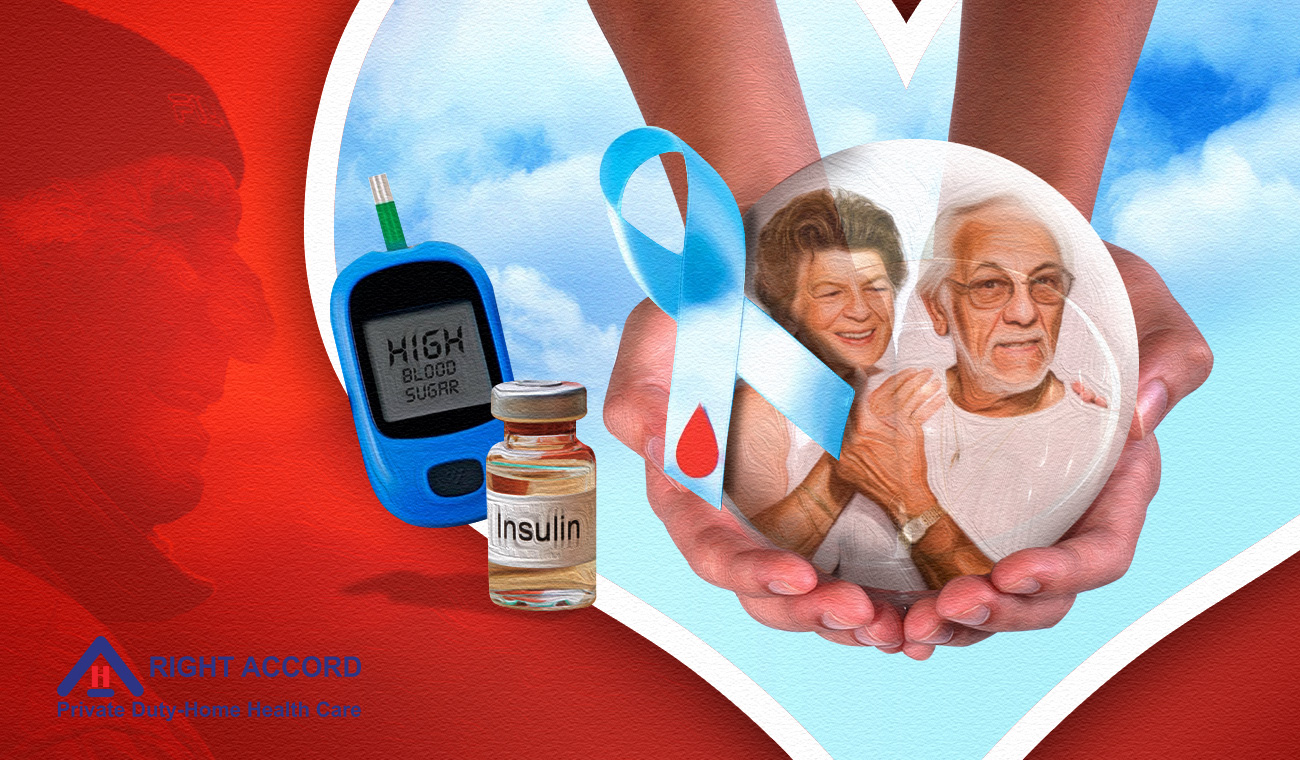· 7 min read
How to Effectively Implement Diabetes Care in the Elderly
Diabetes is a disease of unnatural glucose metabolism resulting in high blood sugar levels. Read more and learn about the proper diabetes care in the elderly.

By: Rosemarie Tamunday Casanova — RN, BSN, MHA
Diabetes is a disease of glucose metabolism that occurs when the body is not able to use glucose for energy generation, resulting in high blood sugar levels and poor fat metabolism. There might also be complications like kidney damage, heart disease and cognitive dysfunction among others.
There are basically two types of diabetes:
- Type 1, which results from the absence of insulin (the hormone that facilitates the metabolism of glucose), is noticed earlier in life.
- Type 2 diabetes, which occurs as a result of failure of the body to respond to available insulin, is the most common in elderly people.

The management of type 2 diabetes in the elderly patient is unique in that it requires certain provisions not commonly associated with the traditional diabetes management protocols. This is because the older population often present with certain health conditions that affect their diabetic care.
As diabetes is a long term disease and not everyone who has the predisposition to develop diabetes is aware of it, it is important in this diabetes awareness month of November, to consider some special care guidelines for diabetes, with a focus on the elderly whose care differ markedly from that of younger individuals.
Elderly Persons With diabetes - A Growing Population With Extraordinary Challenges
More and more elderly persons are becoming diabetic. Available statistics show that people aged 65 years and above make up 25% of diabetes patients. Over the next 20 years, it is estimated that the figures will significantly increase.
This demographic is often at a greater risk of having complications arising from blood vessel dysfunction, leading to lower limb amputations, heart disease, eye problems, and kidney disorders, when compared with their younger counterparts.
This comes with huge economic and health costs. Older people are often dependent and therefore it is important to have a tailored approach to their care. Also, a unique approach will help avoid the complications of treatment which are unique to them owing to increasing age and reduced physiologic ability to adapt.
Why Diabetes Care In The Elderly Is Unique
In elderly patients, there is an appreciable variability in terms of clinical presentation, access to resources, and psychosocial circumstances. Diabetes care can vary according to where the patient lives such as a care home or with family members. It can vary according to the availability of funding and health care as well as the overall health or wellbeing of the patients.
A well functioning patient might require a less supervised care regimen while a dependent patient would obviously need supervision. In the same vein, a younger patient might tolerate treatment that could be dangerous to a much older patient like the use of potent blood sugar lowering drugs. The older patients are more likely to have co-morbidities that put them at a higher risk of treatment failure or development of complication. These include cognitive dysfunction, depression, chronic pain, urinary incontinence and physical disabilities such as arthritis and ambulatory problems.
Therefore, the main aim of diabetes care in the elderly is to take cognisance of the presence or absence of these co-morbidities as well as the patient’s living conditions and availability of funding. Considering these peculiarities in the elderly, various guidelines for management have been created globally.

Photo by Matt Chesin Unsplash
Guidelines Of Diabetes Care In The Elderly
According to the International Diabetes Federation, there should be individualized targeted sugar levels to be attained based on the functionality of the patient, the presence or absence of co-morbidities, the risk of low blood sugar and blood vessel complications like occlusion.
Special considerations
The following are important considerations to make when creating management plans and treatment strategies for elderly persons with diabetes:
Occurrence of age-related health conditions:
When treating or caring for elderly patients with diabetes, it is important to remember that they are at a higher risk of having comorbidities (geriatric syndromes) which include depression, disordered cognitive function, functional disabilities, polypharmacy, arthritis, etc. All these affect the kind of treatment a patient requires and their adherence to it.
For instance, a depressed patient might refuse to take medications if unsupervised. Likewise, cognitive dysfunction might cause forgetfulness and polypharmacy (the need to take too many drugs) could lead to increased drug Interactions. Conditions like incontinence and difficulty with ambulation could lead to a lowered quality of life.
These could hinder the ability of a patient to perform diabetes self-care. Thus, it is important for the clinician and caregiver to recognize these factors when instituting and carrying out treatment for elderly patients.
Elderly patients who can’t perform self-care should be given more simplified and supervised treatment options.
Risk of hyperglycemia:
Hypoglycemia (low blood sugar) is one of the most common limiting factors when formulating desired treatment plans. In older patients, the risk of hypoglycemia and poor outcome is even higher and this is owing to their reduced ability to respond physiologically and adapt to low blood sugar levels.
It is therefore crucial that in the elderly population, individualized care and treatment plans which recognize these risks associated with hypoglycemia, should be instituted. Dieting and exercise should instead be emphasized.

Photo by Towfiqu Barbhuiya on Unsplash
Management
Since older patients usually differ from their younger counterparts in their blood sugar control goals and have higher prevalence of comorbidities which interfere with self-care, it is important for caregivers to be well informed of these peculiarities. Pharmacotherapeutic strategies should ideally be adapted to suit individual differences. It is recommended that lifestyle modifications be considered first, however without being too stringent and restricting.
Obese patients should aim to lose weight, eat low calorie diets while engaging in exercise adequate for age and health circumstances. For instance elderly patients who cannot do vigorous exercise are encouraged to walk about the house in short minutes at a time.
If lifestyle modification is not enough, then both injectable and oral anti-diabetic drugs are recommended. However, it has been advised that drug therapy should be made simple and as few as possible to enable compliance. An example is use of daily single dosing insulin complemented with oral drugs, in place of multiple dosing of insulin and/or oral options.
November Is Diabetes Awareness Month
The theme for this year’s awareness month is diabetes care in the elderly. It emphasizes the uniqueness of diabetes care in the elderly. This month can be used to spread awareness of diabetes care in the elderly.
How can you participate?
Get informed:
The first step is to try to learn more about diabetes care in the elderly. This you can do by attending the many lectures and symposia that would be taking place this month.
You can learn about the importance of early detection of diabetes, the role of proper dieting and exercise which are very beneficial to the elderly population.
You can also learn the importance of routine finger prick blood sugar monitoring over other more complicated tests in detecting short term fluctuations in blood sugar. You can learn about risk factors of diabetes like obesity, sedentary life style and poor diet.

Photo by Neonbrand Unsplash
You can help others:
You can help educate people in your immediate environment about the things you learn about diabetes. You can share your proper dieting recipes with them and encourage them to exercise.
You can help with funding:
You can join the advocacy for greater funding for organizations working to help more people access care in their old age. You can also provided financial assistance.



